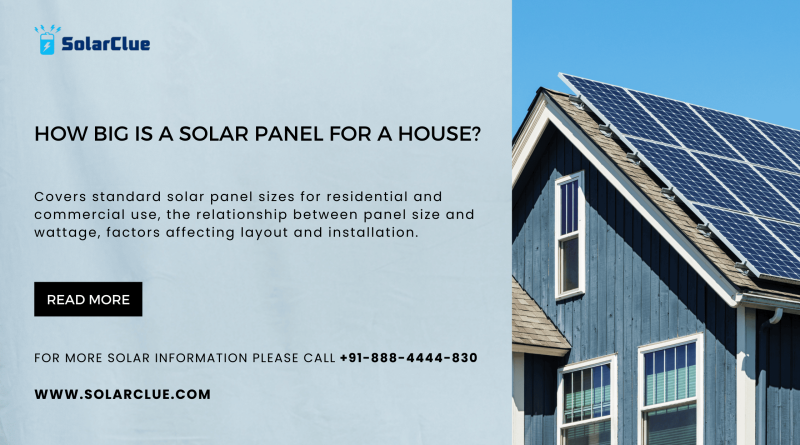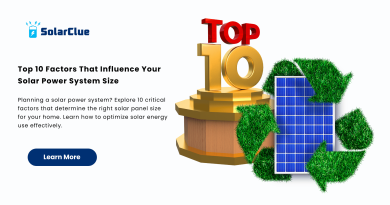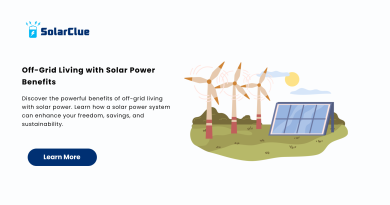How Big Is A Solar Panel For A House?
Selecting the right size and dimensions for solar panels is crucial for maximizing efficiency and ensuring a successful installation. This blog covers standard solar panel sizes for residential and commercial use, the relationship between panel size and wattage, factors affecting layout and installation, and tips for optimizing output based on size and placement.
Table of Contents
- 1 Standard Solar Panel Dimensions and Sizes
- 1.1 Residential Solar Panels
- 1.2 The Relationship Between Panel Size and Wattage
- 1.3 Factors Affecting Solar Panel Layout and Design
- 1.4 Optimizing Solar Panel Placement for Maximum Efficiency
- 1.5 The Impact of Panel Size on System Aesthetics
- 1.6 Considerations for Different Roof Types and Orientations
- 1.7 The Future of Solar Panel Size and Design Trends
- 1.8 How Panel Size Affects System Cost and Installation Time
- 1.9 Conclusion
- 1.10 FAQs
Standard Solar Panel Dimensions and Sizes
Solar panels come in various sizes, primarily differentiated by their application in residential or commercial settings.
Residential Solar Panels
- Typical Dimensions: Approximately 65 inches by 39 inches (165 cm by 100 cm)
- Number of Cells: Usually 60 cells per panel
- Average Weight: Around 40 pounds (18 kg)
Commercial Solar Panels
- Typical Dimensions: Approximately 77 inches by 39 inches (195 cm by 100 cm)
- Number of Cells: Usually 72 cells per panel
- Average Weight: Around 50 pounds (23 kg)
The Relationship Between Panel Size and Wattage
The size of a solar panel is closely related to its wattage and efficiency. Larger panels with more cells generally produce higher wattage. For example:
- 60-cell Panels: Typically produce between 250-350 watts
- 72-cell Panels: Typically produce between 350-450 watts
Higher wattage panels can generate more electricity, but their efficiency (the ability to convert sunlight into electricity) also plays a crucial role. Efficiency is influenced by the quality of the cells and the materials used in the panel.
Factors Affecting Solar Panel Layout and Design
Roof Space
The available roof space significantly impacts the layout and design of a solar panel system. Panels must be arranged to maximize exposure to sunlight while avoiding shading from obstacles like chimneys and trees.
Orientation
The orientation of the roof affects how much sunlight the panels receive. In the Northern Hemisphere, south-facing roofs are ideal, while north-facing roofs are preferred in the Southern Hemisphere.
Roof Type
Different roof types and materials can influence installation complexity and cost. Common roof types include:
- Flat Roofs: Often require mounting structures to angle the panels toward the sun.
- Sloped Roofs: Panels are typically installed flush with the roof surface, making orientation and tilt angle crucial.
Optimizing Solar Panel Placement for Maximum Efficiency
Angle and Tilt
The tilt angle of solar panels should be optimized based on the geographic location to maximize sunlight exposure. Generally, the tilt angle should match the latitude of the installation site.
Shading Analysis
Conducting a shading analysis helps identify potential obstructions that could reduce panel efficiency. Avoiding shaded areas ensures maximum energy production.
Spacing
Proper spacing between panels allows for adequate ventilation, reducing the risk of overheating and maintaining efficiency.
The Impact of Panel Size on System Aesthetics
Larger panels can cover more roof space and may be more visually prominent, affecting the aesthetics of the building. However, fewer large panels can sometimes look cleaner and more streamlined than many smaller panels.
Considerations for Different Roof Types and Orientations
Flat Roofs
- Advantages: Easier to install mounting structures to achieve the desired tilt.
- Challenges: Requires careful planning to avoid shading and ensure structural support.
Sloped Roofs
- Advantages: Typically require less mounting hardware and can be more visually appealing.
- Challenges: Orientation and tilt are fixed, so panel placement must be optimized for maximum exposure.
The Future of Solar Panel Size and Design Trends
Emerging trends in solar panel design focus on increasing efficiency and reducing size. Advances in materials, such as bifacial panels that capture sunlight on both sides, and the development of more efficient photovoltaic cells, are paving the way for more compact and powerful panels.
How Panel Size Affects System Cost and Installation Time
Cost Implications
- Larger Panels: Can reduce installation time and labor costs as fewer panels are needed.
- Smaller Panels: May be easier to handle and install in tight spaces but can increase overall installation time and complexity.
Installation Time
The size and number of panels impact the installation timeline. Larger panels can speed up the process, while more panels require additional mounting and wiring efforts.
Conclusion
Understanding the dimensions and sizes of solar panels is crucial for optimizing their placement and maximizing efficiency. By considering factors such as roof space, orientation, and panel efficiency, homeowners and businesses can make informed decisions that enhance the performance and aesthetics of their solar power systems.
Here at SolarClue®, we offer a smart, practical, and “beautiful” solution. You will be answered for all the questions related to Solar.
We provide all kinds of brands that are the Best Solar panels in India.
If you are the one who is planning for the solar power system. Don’t hesitate to contact our team!
Looking forward to empowering you with solar energy, just like hundreds of our other clients!
FAQs
1. What are the standard dimensions of residential solar panels?
Residential solar panels typically measure about 65 inches by 39 inches.
2. How does panel size affect wattage?
Larger panels with more cells generally produce higher wattage, but efficiency also plays a crucial role.
3. What factors influence solar panel layout?
Roof space, orientation, roof type, and shading are key factors that influence panel layout and design.
4. How can I optimize solar panel placement for maximum efficiency?
Optimize tilt angle based on geographic location, conduct shading analysis, and ensure proper spacing for ventilation.
5. What are the future trends in solar panel design?
Future trends include more efficient photovoltaic cells, bifacial panels, and compact, high-power panels.



